Bangor, County Down: Difference between revisions
m clean up, typos fixed: working class people → working-class people |
No edit summary |
||
| (2 intermediate revisions by the same user not shown) | |||
| Line 15: | Line 15: | ||
|constituency=North Down | |constituency=North Down | ||
}} | }} | ||
'''Bangor''' is a | '''Bangor''' is a city on the north coast of [[County Down]]. It is reckoned the most populous town in Northern Ireland after [[Belfast]] and [[Londonderry]]. Bangor is a seaside resort situated on the southern side of [[Belfast Lough]] and is situated in the Belfast Metropolitan Area. Bangor Marina is one of the largest in Ireland, and holds Blue Flag status.<ref>{{cite web|url=http://www.blueflag.org/blueflag/2006/UnitedKingdom/NorthernIreland/BangorMarina |title=Bangor Marina |publisher=Blue Flag Programme|date=|accessdate=30 April 2010}}</ref> In 2007, and again in 2008, the town was voted by Ulster Television viewers as the most desirable place to live in Ulster.<ref>[http://u.tv/newsroom/indepth.asp?id=12926&pt=e Bangor voted most desirable place to live], UTV News, 3 August 2007</ref> Bangor was granted [[List of cities in the United Kingdom|city status]] by Letters Patent on 2 December 2022.<ref>{{Cite news |date=2022-12-02 |title=Bangor receives city status in Princess Anne visit |language=en-GB |publisher=BBC News |url=https://www.bbc.com/news/uk-northern-ireland-63828321 |access-date=2022-12-02}}</ref> | ||
It is primarily residential and can be viewed as a commuter town for the Greater Belfast area, from which it is linked by the A2 road and a direct railway line. Bangor is 13½ miles east of the heart of Belfast and thirty minutes by train or bus with George Best Belfast City Airport even closer. | It is primarily residential and can be viewed as a commuter town for the Greater Belfast area, from which it is linked by the A2 road and a direct railway line. Bangor is 13½ miles east of the heart of Belfast and thirty minutes by train or bus with George Best Belfast City Airport even closer. | ||
Bangor is also host to the Royal Ulster Yacht Club and the Ballyholme Yacht Club. Tourism is important, particularly in the summer months, and plans are being made for the redevelopment of the seafront; a notable building in the | Bangor is also host to the Royal Ulster Yacht Club and the Ballyholme Yacht Club. Tourism is important, particularly in the summer months, and plans are being made for the redevelopment of the seafront; a notable building in the city is Bangor Old Custom House. The largest remaining individual land owner in the area is the Clandeboye Estate, located a few miles from the city centre. | ||
==Name== | ==Name== | ||
| Line 26: | Line 26: | ||
==Arms of the former Borough== | ==Arms of the former Borough== | ||
The shield is emblazoned with two ships, which feature the [[Ulster#Red Hand of Ulster|Red Hand of Ulster]] on their sails, denoting that Bangor is in the province of [[Ulster]]. The blue and white stripes on the shield show that Bangor is a seaside town. Supporting the shield are two dolphins, signifying Bangor's links with the sea. Each is charged with a gold roundle; the left featuring a shamrock, and the right featuring a bull's head, possibly in reference to the derivation of the | The shield is emblazoned with two ships, which feature the [[Ulster#Red Hand of Ulster|Red Hand of Ulster]] on their sails, denoting that Bangor is in the province of [[Ulster]]. The blue and white stripes on the shield show that Bangor is a seaside town. Supporting the shield are two dolphins, signifying Bangor's links with the sea. Each is charged with a gold roundle; the left featuring a shamrock, and the right featuring a bull's head, possibly in reference to the derivation of the city's name. The arms are crested by a haloed St Comgall, founder of the city's abbey, who was an important figure in the spread of Christianity. The motto reads ''Beannchor'', the archaic form of the city's name in the Irish language. | ||
==History== | ==History== | ||
| Line 33: | Line 33: | ||
===Bangor Abbey=== | ===Bangor Abbey=== | ||
[[File:Hereford Mappa Mundi detail Britain.jpg|thumb|The Hereford ''Mappa Mundi'']] | [[File:Hereford Mappa Mundi detail Britain.jpg|thumb|The Hereford ''Mappa Mundi'']] | ||
The Annals of Ulster tells us that the monastery of Bangor was founded by Saint Comgall in approximately 555<ref>{{cite web|url=http://www.ucc.ie/celt/published/G100001A/text125.html |title=Eclesia Bennchuir fundata est. |publisher=University College Cork|date=|accessdate=30 April 2010}}</ref> and was where the ''Antiphonarium Benchorense'' was written, a copy of which can be seen in the | The Annals of Ulster tells us that the monastery of Bangor was founded by Saint Comgall in approximately 555<ref>{{cite web|url=http://www.ucc.ie/celt/published/G100001A/text125.html |title=Eclesia Bennchuir fundata est. |publisher=University College Cork|date=|accessdate=30 April 2010}}</ref> and was where the ''Antiphonarium Benchorense'' was written, a copy of which can be seen in the city's heritage centre. The monastery had such widespread influence that the town is one of only four places in Ireland to be named on the Hereford ''Mappa Mundi'' in 1300. The monastery, which stood roughly where the Church of Ireland church, Bangor Abbey, now stands at the head of the town, became a centre of great learning and was among the most eminent of Europe's missionary institutions in the Early Middle Ages, although it also suffered greatly at the hands of Viking raiders in the 8th century and the 9th century. Malachy was elected Abbot of the monastery in 1123, a year before being consecrated Bishop of Connor. His extensive travels around Europe inspired him to rejuvenate the monasteries in Ireland, and he replaced the existing wooden huts with stone buildings; all that remains today of these is a solitary wall beside the current Bangor Abbey, supposed to be part of the monastery's refectory. | ||
Despite the decline of the monastery, its influence can still be observed in the modern | Despite the decline of the monastery, its influence can still be observed in the modern city; streets names such as Abbots Close and Abbots Walk in the area of the Abbey give clues as to the city's illustrious ecclesiastical past. Bangor's founder, Comgall, was born in Antrim in 517. Originally a soldier, he soon took monastic vows and was educated for his new life. He is next seen in the Irish annals as a hermit on Lough Erne, however his rule was so severe that seven of his fellow monks died. He was persuaded to leave and establish a house at Bangor (or Beannchar, from the Irish "Horned Curve", probably in reference to the bay) in the famed Vale of the Angels. The earliest Irish annals give 558 as the date of Bangor's commencement. | ||
===Bangor Mór and Perpetual Psalmody=== | ===Bangor Mór and Perpetual Psalmody=== | ||
| Line 49: | Line 49: | ||
===17th and 18th centuries=== | ===17th and 18th centuries=== | ||
[[File:OldCustomHouse1.jpg|thumb|The Old Custom House]] | [[File:OldCustomHouse1.jpg|thumb|The Old Custom House]] | ||
The modern | The modern city had its origins in the early 17th century when James Hamilton arrived in Bangor, having been granted lands in north Downshire by King James I and VI in 1605. The Old Custom House, which was completed by Hamilton in 1637 after James I granted Bangor the status of a port in 1620, is a visible reminder of the new order introduced by Hamilton and his Scots settlers, and is one of the oldest buildings in Ireland to have been in continual use. In the 17th century [[Ulster]] ports began to rise in prominence. In 1625 William Pitt was appointed as Customer of the ports of [[Newcastle, County Down|Newcastle]], [[Dundrum, County Down|Dundrum]], [[Killough]], [[Portaferry]], [[Donaghadee]], Bangor and [[Holywood]]. In 1637 the Surveyor General of Customs issued a report compiled from accounts of customs due from each port and their "subsidiary creeks". Of the Ulster ports on the list, [[Carrickfergus]] was first, followed by Bangor, [[Donaghadee]], and [[Strangford]].<ref name="OB">{{cite book | last=O'Sullivan, Aidan & Breen, Colin| year=2007 |title=Maritime Ireland. An Archaeology of Coastal Communities | publisher=Tempus | location=Stroud | pages=211–212 |isbn=978-0-7524-2509-2}}</ref> | ||
The town was an important source of customs revenue for the Crown and in the 1780s Colonel Robert Ward improved the harbour and promoted the cotton industries; today's picturesque seafront was the location of several large steam-powered cotton mills, which employed over three hundred people. The construction of a large stone market house around this time, now used by the Northern Bank, is a testament to the increasing prosperity of the town. | The town was an important source of customs revenue for the Crown and in the 1780s Colonel Robert Ward improved the harbour and promoted the cotton industries; today's picturesque seafront was the location of several large steam-powered cotton mills, which employed over three hundred people. The construction of a large stone market house around this time, now used by the Northern Bank, is a testament to the increasing prosperity of the town. | ||
| Line 69: | Line 69: | ||
With the growing popularity of inexpensive foreign holidays from the 1960s onwards, Bangor declined as a tourist resort and was forced to rethink its future. The second half of the 20th century saw its role as a dormitory town for Belfast become more important. Its population increased dramatically; from around 14,000 in 1930 it had reached 40,000 by 1971 and 58,000 by the end of the century (some council publicity material counting it as high as 70,000), making it one of the ten largest settlements in all of Ireland. The late 1960s also saw work begin on the construction of the Ring Road around the town. | With the growing popularity of inexpensive foreign holidays from the 1960s onwards, Bangor declined as a tourist resort and was forced to rethink its future. The second half of the 20th century saw its role as a dormitory town for Belfast become more important. Its population increased dramatically; from around 14,000 in 1930 it had reached 40,000 by 1971 and 58,000 by the end of the century (some council publicity material counting it as high as 70,000), making it one of the ten largest settlements in all of Ireland. The late 1960s also saw work begin on the construction of the Ring Road around the town. | ||
Currently the seafront of the | Currently the seafront of the city is awaiting redevelopment and has been for over a decade, with a large part of the frontage already demolished, leaving a patch of derelict ground facing onto the marina. Because of this, a great deal of local controversy surrounds this process and the many plans put forward by the council and developers for the land; in November 2009, it was voted by UTV viewers as "Ulster's Biggest Eyesore". A state of the art recycling centre is being built in Balloo Industrial Estate, supposed to be one of the most advanced in Europe. It opened in the summer of 2008.<ref>[http://www.northdown.gov.uk Balloo Recycling Centre] North Down Borough Council</ref><ref>[http://www.ceequal.com/awards_053.htm Balloo Waste Transfer Station and Recycling Centre, Bangor] CEEQUAL</ref> | ||
==Places of interest== | ==Places of interest== | ||
| Line 125: | Line 125: | ||
*[http://www.bangor-local.com/ Bangor Local] | *[http://www.bangor-local.com/ Bangor Local] | ||
*[http://www.inyourfootsteps.com/sailing/harbours/118/bangor_harbour_%26_marina_county_down_ireland Directions for visiting boats] | *[http://www.inyourfootsteps.com/sailing/harbours/118/bangor_harbour_%26_marina_county_down_ireland Directions for visiting boats] | ||
{{Cities in the United Kingdom}} | |||
Latest revision as of 19:33, 25 January 2023
| Bangor | |
| County Down | |
|---|---|
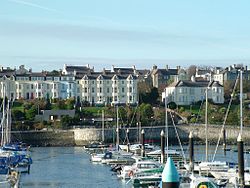 Houses overlooking Bangor Harbour | |
| Location | |
| Grid reference: | J501816 |
| Location: | 54°39’36"N, 5°40’12"W |
| Data | |
| Population: | 76,403 (2001) |
| Post town: | Bangor |
| Postcode: | BT19, BT20 |
| Dialling code: | 028 |
| Local Government | |
| Council: | Ards and North Down |
| Parliamentary constituency: |
North Down |
Bangor is a city on the north coast of County Down. It is reckoned the most populous town in Northern Ireland after Belfast and Londonderry. Bangor is a seaside resort situated on the southern side of Belfast Lough and is situated in the Belfast Metropolitan Area. Bangor Marina is one of the largest in Ireland, and holds Blue Flag status.[1] In 2007, and again in 2008, the town was voted by Ulster Television viewers as the most desirable place to live in Ulster.[2] Bangor was granted city status by Letters Patent on 2 December 2022.[3]
It is primarily residential and can be viewed as a commuter town for the Greater Belfast area, from which it is linked by the A2 road and a direct railway line. Bangor is 13½ miles east of the heart of Belfast and thirty minutes by train or bus with George Best Belfast City Airport even closer.
Bangor is also host to the Royal Ulster Yacht Club and the Ballyholme Yacht Club. Tourism is important, particularly in the summer months, and plans are being made for the redevelopment of the seafront; a notable building in the city is Bangor Old Custom House. The largest remaining individual land owner in the area is the Clandeboye Estate, located a few miles from the city centre.
Name
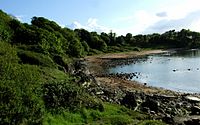
Originally called "Inver Beg" after the (now culverted) stream which ran past the abbey,[4] the name Bangor is derived from the Irish word Beannchar (archaically Beannchor, as seen on the town crest) meaning a horned or peaked curve or perhaps a staked enclosure, as the shape of Bangor Bay resembles the horns of a bull. It may also be linked to Beanna, the Irish for cliffs. The area was also known as The Vale of Angels, as Saint Patrick once rested there and is said to have had a vision filled with angels.[5]
Arms of the former Borough
The shield is emblazoned with two ships, which feature the Red Hand of Ulster on their sails, denoting that Bangor is in the province of Ulster. The blue and white stripes on the shield show that Bangor is a seaside town. Supporting the shield are two dolphins, signifying Bangor's links with the sea. Each is charged with a gold roundle; the left featuring a shamrock, and the right featuring a bull's head, possibly in reference to the derivation of the city's name. The arms are crested by a haloed St Comgall, founder of the city's abbey, who was an important figure in the spread of Christianity. The motto reads Beannchor, the archaic form of the city's name in the Irish language.
History
Bangor has a long and varied history, from the Bronze Age people whose swords were discovered in 1949 or the Viking burial found on Ballyholme beach, to the Victorian pleasure seekers who travelled on the new railway from Belfast to take in the sea air. The town has been the site of a monastery renowned throughout Europe for its learning and scholarship, the victim of violent Viking raids in the 8th and 9th centuries, and the new home of Scottish and English planters during the Plantation of Ulster. The town has prospered as an important port, a centre of cotton production, and a Victorian and Edwardian holiday resort. Today it is a large retail centre and a commuter town for Belfast, though the remnants of the town's varied past still shape its modern form.
Bangor Abbey
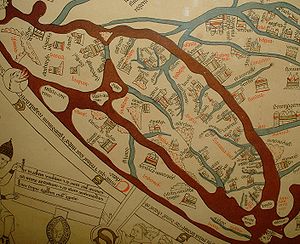
The Annals of Ulster tells us that the monastery of Bangor was founded by Saint Comgall in approximately 555[6] and was where the Antiphonarium Benchorense was written, a copy of which can be seen in the city's heritage centre. The monastery had such widespread influence that the town is one of only four places in Ireland to be named on the Hereford Mappa Mundi in 1300. The monastery, which stood roughly where the Church of Ireland church, Bangor Abbey, now stands at the head of the town, became a centre of great learning and was among the most eminent of Europe's missionary institutions in the Early Middle Ages, although it also suffered greatly at the hands of Viking raiders in the 8th century and the 9th century. Malachy was elected Abbot of the monastery in 1123, a year before being consecrated Bishop of Connor. His extensive travels around Europe inspired him to rejuvenate the monasteries in Ireland, and he replaced the existing wooden huts with stone buildings; all that remains today of these is a solitary wall beside the current Bangor Abbey, supposed to be part of the monastery's refectory.
Despite the decline of the monastery, its influence can still be observed in the modern city; streets names such as Abbots Close and Abbots Walk in the area of the Abbey give clues as to the city's illustrious ecclesiastical past. Bangor's founder, Comgall, was born in Antrim in 517. Originally a soldier, he soon took monastic vows and was educated for his new life. He is next seen in the Irish annals as a hermit on Lough Erne, however his rule was so severe that seven of his fellow monks died. He was persuaded to leave and establish a house at Bangor (or Beannchar, from the Irish "Horned Curve", probably in reference to the bay) in the famed Vale of the Angels. The earliest Irish annals give 558 as the date of Bangor's commencement.
Bangor Mór and Perpetual Psalmody
At Bangor, Comgall instituted a rigid monastic rule of incessant prayer and fasting. Far from turning people away, this ascetic rule attracted thousands. When Comgall died in 602, the annals report that three thousand monks looked to him for guidance. Bangor Mór, named "Great Bangor" to distinguish it from like-named towns in Great Britain, became the greatest monastic school in Ulster as well as one of the three leading lights of Celtic Christianity. The others were Iona, the great missionary centre founded by Colomba, and Bangor on the Dee, founded by Dinooth; the ancient Welsh Triads also confirm the "Perpetual Harmonies" at this great house.
Throughout the sixth century, Bangor became famous for its choral psalmody. "It was this music which was carried to the Continent by the Bangor Missionaries in the following century".[7] Divine services of the seven hours of prayer were carried out throughout Bangor's existence, however the monks went further and carried out the practice of laus perennis. In the twelfth century, Bernard of Clairvaux spoke of Comgall and Bangor, stating, "the solemnization of divine offices was kept up by companies, who relieved each other in succession, so that not for one moment day and night was there an intermission of their devotions." This continuous singing was antiphonal in nature, based on the call and response reminiscent of Patrick's vision, but also practiced by St Martin's houses in Gaul. Many of these psalms and hymns were later written down in the Antiphonary of Bangor which came to reside in Colombanus' monastery at Bobbio, Italy.
The Bangor Missionaries
The ascetic life of prayer and fasting were the attractions of Bangor. However, as time progressed, Bangor also became a famed seat of learning and education. There was a saying in Europe at the time that if a man knew Greek he was bound to be an Irishman, largely due to the influence of Bangor. The monastery further became a missions-sending community. Even to this day missionary societies are based in the town. Bangor Monks appear throughout mediæval literature as a force for good.
In 580, a Bangor monk named Mirin took Christianity to Paisley, where he died "full of miracles and holiness". In 590, the fiery Colombanus, one of Comgall's leaders, set out from Bangor with twelve other brothers, including Gall who planted monasteries throughout Switzerland. In Burgundy he established a severe monastic rule at Luxeuil-les-Bains which mirrored that of Bangor. From there he went to Bobbio in Italy and established the house which became one of the largest and finest monasteries in Europe. Colombanus died in 615, but by 700 AD, one hundred additional monasteries had been planted throughout France, Germany and Switzerland. Other famed missionary monks who went out from Bangor include Molua, Findchua and Luanus.
17th and 18th centuries
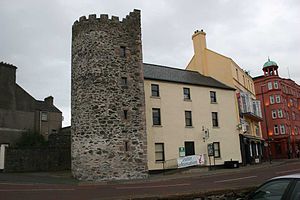
The modern city had its origins in the early 17th century when James Hamilton arrived in Bangor, having been granted lands in north Downshire by King James I and VI in 1605. The Old Custom House, which was completed by Hamilton in 1637 after James I granted Bangor the status of a port in 1620, is a visible reminder of the new order introduced by Hamilton and his Scots settlers, and is one of the oldest buildings in Ireland to have been in continual use. In the 17th century Ulster ports began to rise in prominence. In 1625 William Pitt was appointed as Customer of the ports of Newcastle, Dundrum, Killough, Portaferry, Donaghadee, Bangor and Holywood. In 1637 the Surveyor General of Customs issued a report compiled from accounts of customs due from each port and their "subsidiary creeks". Of the Ulster ports on the list, Carrickfergus was first, followed by Bangor, Donaghadee, and Strangford.[8]
The town was an important source of customs revenue for the Crown and in the 1780s Colonel Robert Ward improved the harbour and promoted the cotton industries; today's picturesque seafront was the location of several large steam-powered cotton mills, which employed over three hundred people. The construction of a large stone market house around this time, now used by the Northern Bank, is a testament to the increasing prosperity of the town.
The end of the 18th century was a time of great political and social turmoil in Ireland, as the United Irishmen, inspired by the American and French Revolutions, sought to achieve a greater degree of independence from Great Britain. On the morning of 10 June 1798 a force of United Irishmen, mainly from Bangor, Donaghadee, Greyabbey and Ballywalter attempted to occupy the nearby town of Newtownards. They met with musket fire from the market house and were subsequently defeated.
Victorian Era

By the middle of the 19th century, the cotton mills had declined and the town changed in character once again. The laying of the railway in 1865 meant that inexpensive travel from Belfast was possible, and working-class people could afford for the first time to holiday in the town. Bangor soon became a fashionable resort for Victorian holidaymakers, as well as a desirable home to the wealthy. Many of the beautiful houses overlooking Bangor Bay (some of which have now been demolished to make way for modern apartments) date from this period. The belief in the restorative powers of the sea air meant that the town became a popular location for sea bathing and marine sports, and the number of visitors from Great Britain increased during the Edwardian period at the beginning of the 20th century, which also saw the improvement of Ward Park and the Marine Gardens.
On 12 July 1867, despite the Party Processions Acts, the Orange Order paraded from Bangor to Newtownards. It was organised by William Johnston and about 30,000 took part.[9]
20th century and beyond
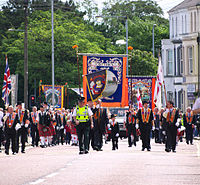
The inter-war period of the early 20th century saw the development of the fondly remembered Tonic Cinema, Pickie Pool and Caproni's ballroom — all three among the foremost of their type in Ireland. All three no longer exist, although there is a fun park named Pickie. This park has a small children's paddling pool, and was created as the original Pickie's was demolished due to the rejuvenation of Bangor seafront in the 1980s and early 1990s.
In 1944 during Second World War, Dwight D Eisenhower addressed Allied troops in Bangor, who were departing to take part in the D-Day landings. In 2005, his granddaughter Mary-Jean Eisenhower came to the town to oversee the renaming of the marina's North Pier as the Eisenhower Pier.
With the growing popularity of inexpensive foreign holidays from the 1960s onwards, Bangor declined as a tourist resort and was forced to rethink its future. The second half of the 20th century saw its role as a dormitory town for Belfast become more important. Its population increased dramatically; from around 14,000 in 1930 it had reached 40,000 by 1971 and 58,000 by the end of the century (some council publicity material counting it as high as 70,000), making it one of the ten largest settlements in all of Ireland. The late 1960s also saw work begin on the construction of the Ring Road around the town.
Currently the seafront of the city is awaiting redevelopment and has been for over a decade, with a large part of the frontage already demolished, leaving a patch of derelict ground facing onto the marina. Because of this, a great deal of local controversy surrounds this process and the many plans put forward by the council and developers for the land; in November 2009, it was voted by UTV viewers as "Ulster's Biggest Eyesore". A state of the art recycling centre is being built in Balloo Industrial Estate, supposed to be one of the most advanced in Europe. It opened in the summer of 2008.[10][11]
Places of interest
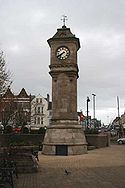
- Bangor Marina
- Clandeboye Estate
- Ward Park
- Clandeboye Park
- Castle Park
 Bangor Abbey
Bangor Abbey- Bangor Carnegie Library
 Bangor Castle
Bangor Castle- Somme Heritage Centre
- Bangor Market House, which dates from the late 18th century, is a 5-bay 2-storey building currently used as a bank
- Bangor Old Custom House
- McKee Clock
Townlands
Bangor and its immediate area have several townlands. Their names predate the settlement of Ulster and are ultimately derived from the Irish language, while newer neighbourhoods have names which come from English and Scots languages. Bangor sprang up in a townland that is now called Corporation. Over time, the surrounding townlands have been built upon and they have given their names too to roads and housing estates.
The following is a list of townlands:
- Balloo ("Hugh's townland")
- Ballyholme ("Hóm's townland")
- Ballycroghan ("townland of the small stack")
- Ballymaconnell ("MacConnell's townland")
- Ballymacormick ("MacCormick's townland")
- Ballymagee ("MacGee's/Magee's townland")
- Ballyree ("townland of the heather")
- Ballyvarnet ("townland of the gap")
- Carnalea ("small mound of the calf")
- Conlig ("stone of the hound")
- Corporation
- Rathgill
Sport
Sailing
Bangor has a high reputation for sailing, hosting great world events and also has high prestige clubs such as the Royal Ulster Yacht Club and Ballyholme Yacht Club which is the venue for Northern Ireland's Elite Sailing Facility.
Motor sport
Every year Bangor hosts the motorcycle World Trials Championships at the marina. Bangor also hosted an off-road karting event on Gransha Road in 2007.
Cricket
Bangor Cricket Club runs five teams now in full league competition and has a reputation for providing one of the best wickets to play on anywhere in Ireland. Not traditionally one of the giants of local cricket, they surprised many people by winning the NCU Senior League Section 1 three seasons ago, thanks largely to the exploits of New Zealander Regan West and all rounder Johnny Hewitt, who have now left the club. The club is now mid-table and looking to heavily develop its next generation. It is greatly aided in this regard by their Sri Lankan professional Yasas Tillakaratne.
Bangor Grammar School won the 2008 Ulster Schools Cricket Cup, which has spurred belief in the future of the cricket club.
References
- ↑ "Bangor Marina". Blue Flag Programme. http://www.blueflag.org/blueflag/2006/UnitedKingdom/NorthernIreland/BangorMarina. Retrieved 30 April 2010.
- ↑ Bangor voted most desirable place to live, UTV News, 3 August 2007
- ↑ "Bangor receives city status in Princess Anne visit" (in en-GB). BBC News. 2022-12-02. https://www.bbc.com/news/uk-northern-ireland-63828321.
- ↑ Bangor Abbey Through Fifteen Centuries. Published 1958. Bangor: Friends of Bangor Abbey. Canon James Hamilton M.A. ISBN 0-9511562-3-3
- ↑ "Bangor Abbey". The Catholic Encyclopedia. http://www.newadvent.org/cathen/02250a.htm. Retrieved 30 April 2010.
- ↑ "Eclesia Bennchuir fundata est.". University College Cork. http://www.ucc.ie/celt/published/G100001A/text125.html. Retrieved 30 April 2010.
- ↑ Hamilton, Rector of Bangor Abbey
- ↑ O'Sullivan, Aidan & Breen, Colin (2007). Maritime Ireland. An Archaeology of Coastal Communities. Stroud: Tempus. pp. 211–212. ISBN 978-0-7524-2509-2.
- ↑ "Parades and Marches - Chronology 2: Historical Dates and Events". Conflict Archive on the Internet (CAIN). http://cain.ulst.ac.uk/issues/parade/chpa2.htm. Retrieved 28 January 2010.
- ↑ Balloo Recycling Centre North Down Borough Council
- ↑ Balloo Waste Transfer Station and Recycling Centre, Bangor CEEQUAL
Outside links
| Cities in the United Kingdom |
|---|
|
Aberdeen • Armagh • Bangor (Caernarfonshire) • Bangor (County Down) • Bath • Belfast • Birmingham • Bradford • Brighton and Hove • Bristol • Cambridge • Canterbury • Cardiff • Carlisle • Chelmsford • Chester • Chichester • Colchester • Coventry • Derby • Doncaster • Dundee • Dunfermline • Durham • Ely • Edinburgh • Exeter • Glasgow • Gloucester • Hereford • Inverness • Kingston upon Hull • Lancaster • Leeds • Leicester • Lichfield • Lincoln • Lisburn • Liverpool • City of London • Londonderry • Manchester • Milton Keynes • Newcastle upon Tyne • Newport • Newry • Norwich • Nottingham • Oxford • Perth • Peterborough • Plymouth • Portsmouth • Preston • Ripon • Rochester • Salford • Salisbury • Sheffield • Southampton • St Albans • St Asaph • St David's • Southend-on-Sea • Stirling • Stoke-on-Trent • Sunderland • Swansea • Truro • Wakefield • Wells • Westminster • Winchester • Wolverhampton • Worcester • Wrexham • York |